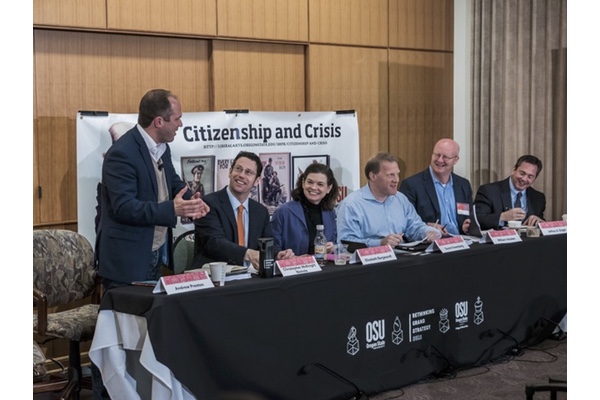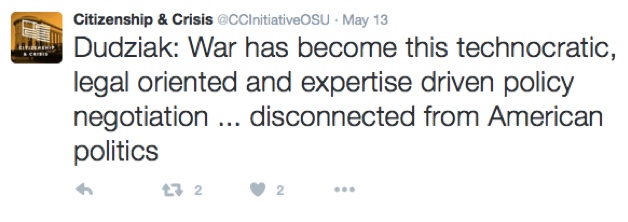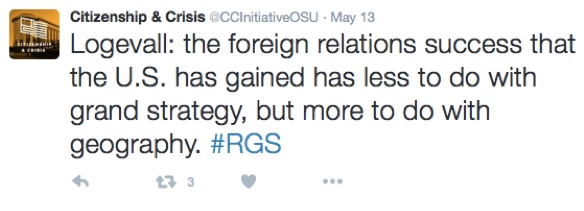Historians meet to consider ways to rethink Grand Strategy in foreign policy

Photo by Mina Carson
A renowned group of scholars met over the weekend at Oregon State University to ‘rethink’ Grand Strategy. At the May 13-14 symposium organized by Elizabeth Borgwardt, Christopher McKnight Nichols, and Andrew Preston, panelists from an array of disciplines presented papers on a similarly diverse number of topics, asking penetrating questions about the relationship between historians and foreign policy, the efficacy of using “grand strategy” as an historical category, and experimenting with different levels of analysis. Can grand strategy move beyond the idea of national state actors to encompass the supranational, the regional, and a more longue durée approach?
To judge from the stimulating conversation in the room, the answer could be considered a resounding ‘yes’. From the first panel to the last, conversation and community abounded (with just the right amount of Lin-Manuel Miranda and Hamilton references). A complete online conference program can be found here.
The first panel, organized under the theme “Grand Strategy and American Foreign Relations, 1776-2016” offered papers that swept across time and space. Charles Edel offered a reading of grand strategy in the Federalist Papers, making a case for a coherent early grand strategy that developed out of a shared Federalist vision of expansion, often depicted as “extending the sphere.” Matt Karp followed by presenting a view of regional grand strategy in the antebellum South, turning to what eventually became a “losing” grand strategy by revealing the capacious “Grand Strategy of the Master Class” (i.e. slave-holding elites who were major players in the U.S.’s foreign relations leading up to the Civil War).
Katherine Epstein suggested that United States foreign relations between 1865 and 1918 present a new and successful grand strategy for the United States’ vision as a world power, and explored problems related to comparisons of the U.S. and the England in this era. She critiqued the concept of Grand Strategy as one that privileges the nation-state as the primary actor, and she pointed out ways in which historians should be skeptical of their ability to know the past or the present in “sufficient detail to enable confident analogies or derive lessons.”

The final paper in the session, offered by David Milne, provided a sweeping narrative of grand strategy after 1919. A heroic task, Milne also left questions for the audience on major conference themes: what unit of analysis is best for understanding grand strategy? Can we move beyond the nation-state? Is it better to think in terms of “ascendant ideas” rather than grand strategies? These questions would return throughout the conference.

The afternoon session offered different takes on “War, Peace, and the Foreign-Domestic Policy Nexus.” First up, Emily Conroy-Krutz moved beyond the nation-state by focusing on missionaries’ work in nineteenth-century China as a means to represent and contribute to America’s global strategy. Perhaps, as one questioner asked, it represented some sort of “Divine Grand Strategy” that extended beyond national boundaries and national goals altogether.

Michaela Hoenicke-Moore then offered an on-the-ground vision of grand strategy, utilizing letters home from soldiers during the Second World War. Hoenicke-Moore argued there was a clear gap between confident elites and a skeptical public opinion before and during World War II. Her paper helped us expand the narrative of ‘war works’ in part by revealing that sources show there was not much general agreement among members of the “Greatest Generation.”
After a quick coffee break, the conference returned to hear Mary Dudziak’s paper on “How War Became a Policy Option.” Dudziak asked questions for audience members to think about the intersection of legal and military aims. She urged us to consider: What were the limits of American global power? What role did legal institutions play in defining the extent of American grand strategy? Dudziak also drew comparisons between the lead-ups to Vietnam in 1963-64 and to the Iraq war in 2003-04, suggesting the importance of an enlightened polity in restraining war.

The last two panelists of the day presented views of grand strategy that reflected different dimensions of demographics. Adriane Lentz-Smith described “Grand Strategy and the Problem of Race,” suggesting a problem with the “unthinking whiteness of Grand Strategy.” Focusing on diplomats Sam Greenlee and Carl Rowan, Lentz-Smith described their visions of American foreign relations, to paraphrase W.E.B. Du Bois, as the problem of the color line. Lentz-Smith’s paper also highlighted the importance of the grand strategic thought of actors not part of the highest echelons of policymaking.
Daniel Tichenor then offered a paper about “Rival Visions of Nationhood: Immigration Policy, Grand Strategy, and Contentious Politics,” making the case for immigration’s complexities and strategies varied across the political spectrum and over time. Whether politicians were in favor of expanded admission and limited rights, or limited admission and expanded rights, or whether they were exclusionists, Tichenor demonstrated that Grand Strategy can play a role in shaping what the whole nation should look like.
One of the many highlights of the conference was the keynote address by Frederik Logevall, Pulitzer-Prize winning Harvard historian. Logevall’s lecture, entitled “American Grand Strategy: How Grand Has It Been? How Much Does It Matter?” reflected the key themes and challenges presented throughout the conference. In short, Logevall answered his own questions as “not very,” and “less than you might think.” Logevall proposed that geography, and demographics, and not necessarily grand strategy, have helped assure the United States’ powerful place in the world.

Logevall also emphasized the close connection between the foreign and the domestic, a theme emphasized in panels earlier that day. The Cold War, he argued, might not have been so varied in temperature were it not for domestic political considerations. He concluded by suggesting if we hold out containment as a success, we have to consider the price the United States paid for that success.
His engaging and fascinating talk to a packed room also encouraged great discussion from audience members, not all of whom were academic historians. It was also recorded by C-SPAN’s “American History TV” television and will be broadcast at a later date, so stay tuned!
Fresh off the tails of a great keynote, the May 14 sessions prompted continued deep thinking and dynamic conversations. The first panel, also covered by C-SPAN, focused on “Major Figures from Woodrow Wilson to Condoleezza Rice” and asked the conference goers to think about different political actors and their maybe-grand strategic goals. Christopher McKnight Nichols offered the first paper, suggesting Woodrow Wilson’s internationalism could be considered Grand Strategy. Identifying four “internationalisms” that emerged in the 1920s and 1930s, Nichols asked for an expanded “epistemological vision” for Grand Strategy. Debate about the role of trade in these internationalisms, too, brought forth a great discussion about the role of economic determinism in American foreign policy and also about how best to explore the role and influence of ideas in international relations.
The second speaker, Elizabeth Borgwardt, asked the audience to consider the role of the Atlantic charter in setting forth a Rooseveltian “rehash” of Wilsonianism. Her paper also urged a broadening of a narrowly defined Grand Strategy, and included FDR, the Atlantic Charter, the Morgenthau Plan, and human rights as crucial points to consider in any expanded exploration of the U.S.’s conception and execution of grand strategy.

The second half of the session emphasized the individual’s role in shaping – or not – grand strategy. David Greenberg’s paper on George Kennan emphasized misanthropy, bigotry, and an “anti-democratic soul” as central to understanding Kennan’s thought.

William Inboden offered an analysis focused more process. Inboden proposed a model for Grand Strategy that relied on both conceptualization and effective implementation, highlighting the role of such execution in the relationship between Nixon and Kissinger in terms of the reformation of the National Security Council. Finally, Jeffery Engel presented a paper on George H.W. Bush’s Grand Strategy. Engel suggested that one of the strengths of Bush 41’s presidency was that he accomplished what he wanted without letting anyone know. Engel especially highlighted German unification post-1989 as a critical moment for Bush’s Grand Strategy and movement towards a worldly democracy.
In the final session, panelists thought about “Rethinking Grand Strategy: Fallacies, Themes, and Theories.” Elizabeth H. Bradley wondered about the application of Grand Strategy to Global Health, offering a grand strategic reading of the implementation of PEPFAR, or the President’s Emergency Plan for AIDS Relief.

Julia F. Irwin also wondered if Grand Strategy could be applied to “Catastrophic Humanitarianism” by looking at the institutionalization of humanitarian relief and foreign assistance throughout the nineteenth and twentieth centuries. Following a coffee break, Ryan Irwin looked at the role legal structures have played in articulating Grand Strategy; suggesting that there may have been generational patterns at work for figures like Felix Frankfurter, Walter Lippmann, and Dean Acheson as “denizens of a center” who articulated a strategic vision of their ideas about power and law.
Finally, Stephen Wertheim took issue with the entire concept of Grand Strategy, delving into and building on divisions between the descriptive and prescriptive projects of Grand Strategy as well as the GS teaching program. Overall he suggested the grand strategy project seems to be too narrow and perhaps too anachronistic as an historical category.

“Rethinking Grand Strategy” asked serious questions and engendered stimulating conversation for all conference goers. Engaging on different topics about the philosophy of history, the role of historians in policy and pedagogy, both in the academy and beyond, and bringing into conversation different fields such as political science or global health, “Rethinking Grand Strategy” offered substantive criticism and engagement with major ideas in American foreign policy and diplomatic history.
“Rethinking Grand Strategy” is also the working title of an edited volume that will result from the conference and is under contract with Oxford University Press. Many thanks also need to be extended to conference lead organizer Christopher McKnight Nichols and the Oregon State University School of History, Philosophy, and Religion for such engaging, critical, and inspiring conversation, as well as to the Oregon State University Citizenship and Crisis Initiative for hosting the event.